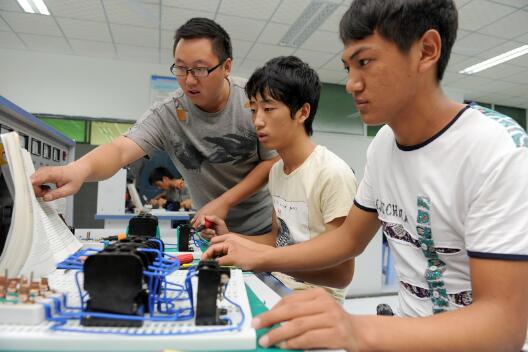Vocational education to play a bigger role in poverty-reduction
Author : WANG SHOUBIN Source : Chinese Social Sciences Today 2017-10-26

Customized measures are required to make vocational education a driving force in targeted poverty alleviation.
The transformation of vocational education can be interpreted as “the application of the spirit of craftsmanship to the perfection of each school.” Therefore, it is necessary to first clarify the educational orientation and objective. In other words, we should answer two fundamental questions about vocational education: Why do we start a school and, what type of talent do we hope to cultivate?
In terms of the goal of vocational education, many people would agree that it aims to “train millions of skilled talent and billions of quality workers,” but they may fail to elaborate on the details. In fact, plenty of secondary vocational schools advertise that they completely focus on the gaokao in order to boost their brands, thus enrolling more students. Many schools seek better political achievements and invest their best manpower, resources and funds into training a few competitive candidates. The candidates account for less than 20 percent of all students but receive more than 80 percent of educational resources, turning technical competitions into “a game for elites.” No doubt, these schools are straying from the purposes of vocational education.
It is said that “No place is out of reach if we find the right path.” When we lose our way, the trip will be tough. If we move toward the wrong direction, then we will head farther and farther away from the destination.
At present, the overall performance of vocational schools at the county and lower level is disappointing. They may revel in the enrollment of one or two students into universities or in the admission of a few into urban factories while ignoring the primary objective of “contributing talent to the regional economy and social development.”
It is understandable that vocational schools in rural areas are passionate about sending their graduates to cities. However, which schools can be relied upon to develop rural economy? Enterprises have every reason to turn their backs on vocational education if they can’t hire workers from these schools. Local enterprises facing tough situations are not able to employ the children who have later dismissed from cities. The vicious cycle has led to persistent poverty in some regions and generations of impoverished populations.
Therefore, vocational education needs to play a bigger role in poverty alleviation. Customized measures are required to make vocational education a driving force in targeted poverty alleviation.
Reforms to the enrollment mechanism are required to prioritize targeted people and give children in impoverished families more opportunities to study in vocational schools as well as giving financial support for their education. Schools should reform the pattern of teaching and learning to help students develop the ability to survive in society and become new farmers that are proficient in operation, management and wealth acquisition. Training should be highlighted by conducting practice exercises and emphasizing skills so that supporting laborers from impoverished families can master practical skills.
It is a form of top-level design to attract and support these children to study in vocational schools or train them to seek jobs and start businesses. To achieve this goal, local governments should increase investment in vocational education and facilities. Cooperation between governments and schools should be promoted, which is the necessary prerequisite that enables vocational education to boost the effectiveness of targeted poverty-reduction. In this way, vocational schools can have better understanding of their orientation and cultivate more qualified talent.
Ye Shengtao made Chinese fairy tales from a wilderness
Ye Shengtao (1894–1988) created the first collection of fairy tales in the history of Chinese children’s literature...
-
How northern ethnicities integrated into Chinese nation
2023-09-18
-
Mogao caves
2023-09-12
-
Mogao Grottoes as ‘a place of pilgrimage’
2023-09-12
-
Time-honored architectural traditions in China
2023-08-29
-
Disentangling the civilizational evolution of China
2023-08-28
-
AI ethics in science fiction
2023-08-23














 2011-2013 by www.cssn.cn. All Rights Reserved
2011-2013 by www.cssn.cn. All Rights Reserved